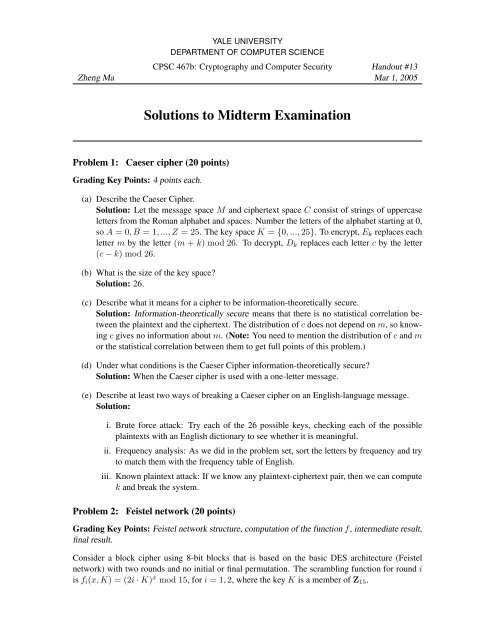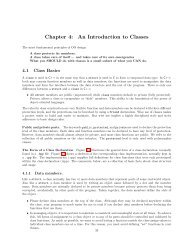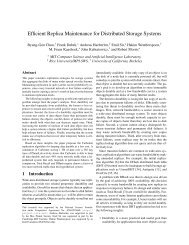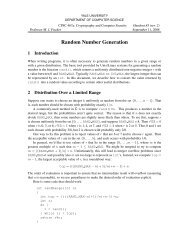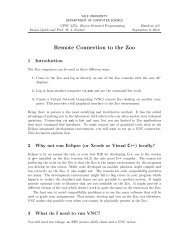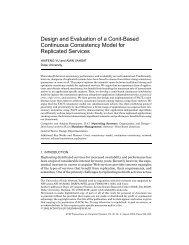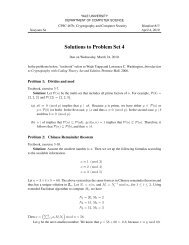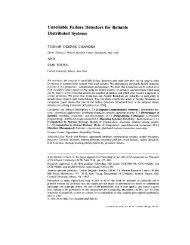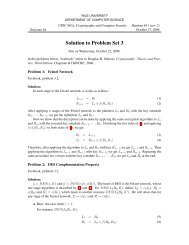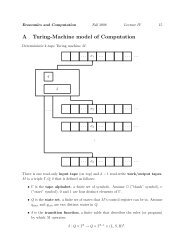Solutions to Midterm Examination - Zoo - Yale University
Solutions to Midterm Examination - Zoo - Yale University
Solutions to Midterm Examination - Zoo - Yale University
Create successful ePaper yourself
Turn your PDF publications into a flip-book with our unique Google optimized e-Paper software.
YALE UNIVERSITYDEPARTMENT OF COMPUTER SCIENCECPSC 467b: Cryp<strong>to</strong>graphy and Computer Security Handout #13Zheng Ma Mar 1, 2005<strong>Solutions</strong> <strong>to</strong> <strong>Midterm</strong> <strong>Examination</strong>Problem 1: Caeser cipher (20 points)Grading Key Points: 4 points each.(a) Describe the Caeser Cipher.Solution: Let the message space M and ciphertext space C consist of strings of uppercaseletters from the Roman alphabet and spaces. Number the letters of the alphabet starting at 0,so A = 0, B = 1, ..., Z = 25. The key space K = {0, ..., 25}. To encrypt, E k replaces eachletter m by the letter (m + k) mod 26. To decrypt, D k replaces each letter c by the letter(c − k) mod 26.(b) What is the size of the key space?Solution: 26.(c) Describe what it means for a cipher <strong>to</strong> be information-theoretically secure.Solution: Information-theoretically secure means that there is no statistical correlation betweenthe plaintext and the ciphertext. The distribution of c does not depend on m, so knowingc gives no information about m. (Note: You need <strong>to</strong> mention the distribution of c and mor the statistical correlation between them <strong>to</strong> get full points of this problem.)(d) Under what conditions is the Caeser Cipher information-theoretically secure?Solution: When the Caeser cipher is used with a one-letter message.(e) Describe at least two ways of breaking a Caeser cipher on an English-language message.Solution:i. Brute force attack: Try each of the 26 possible keys, checking each of the possibleplaintexts with an English dictionary <strong>to</strong> see whether it is meaningful.ii. Frequency analysis: As we did in the problem set, sort the letters by frequency and try<strong>to</strong> match them with the frequency table of English.iii. Known plaintext attack: If we know any plaintext-ciphertext pair, then we can computek and break the system.Problem 2: Feistel network (20 points)Grading Key Points: Feistel network structure, computation of the function f, intermediate result,final result.Consider a block cipher using 8-bit blocks that is based on the basic DES architecture (Feistelnetwork) with two rounds and no initial or final permutation. The scrambling function for round iis f i (x, K) = (2i · K) x mod 15, for i = 1, 2, where the key K is a member of Z 15 .
Handout #13—Mar 1, 2005 3Let n = 13 × 9 = 117.(a) Find a number x ∈ Z n such that:Solution: Here n 1 = 13 and n 2 = 9:{x ≡ 6 (mod 13)x ≡ 3 (mod 9).n = n 1 × n 2 = 117N 1 = n/n 1 = 9, M 1 ≡ N1 −1 ≡ 3 (mod 13)N 2 = n/n 2 = 13, M 2 ≡ N2 −1 ≡ 7 (mod 9)x = a 1 M 1 N 1 + a 2 M 2 N 2 = 6 · 9 · 3 + 3 · 13 · 7 ≡ 84 (mod 117)(b) Explain why the number x you found in part (a) is unique in Z n .Solution 1:To see that the solution is unique in Z 117 , let χ be the mapping x ↦→ (x mod 13, x mod 9).χ is a surjection from Z 117 <strong>to</strong> Z 13 × Z 9 since we have just shown for all (a 1 , a 2 ) ∈ Z 13 × Z 9that there exists x ∈ Z 117 such that χ(x) = (a 1 , a 2 ). χ is also an injection since |Z 117 | =|Z 13 × Z 9 |. Hence, χ is a bijection, so the solution is unique in Z 117 .Solution 2 (Due <strong>to</strong> Melody Chan):{y ≡ x ≡ 6 (mod 13)Suppose that we have y other than above x satisfy the equations:y ≡ x ≡ 3 (mod 9).Then, we show that y ≡ x (mod 117). From above equations, we know that 13 | (y − x)and 9 | (y − x), but gcd(13, 9) = 1, so (13 × 9) | (y − x). So y ≡ x (mod 117)Problem 5: Euler’s theorem (20 points)Grading Key Points: (a) Euler function of the products of two primes, general Euler’s function,final result; (b) Order of an elements, Euler’s theorem, final result.(a) Calculate φ(77) and φ(φ(77)).Solution:φ(77) = φ(7) × φ(11) = 6 × 10 = 60φ(φ(77)) = φ(60) = φ(2 2 × 3 × 5) = (2 − 1) × 2 2−1 × (3 − 1) × (5 − 1) = 16(b) Find a positive integer x < 101 such that 10 5101 ≡ 10 5x (mod 77).Solution:First, we note that gcd(10, 77) = 1, so 10 ∈ Z ∗ 77 . By Euler’s Theorem, we know that10 φ(77) = 10 60 ≡ 1 (mod 77). So we only need <strong>to</strong> find x such that 5 101 ≡ 5 x (mod 60).Note that gcd(5, 60) ≠ 1 so 5 /∈ Z ∗ 60 , and you can’t use Euler’s Theorem again! Also,you can’t use Chinese Remainder Theorem either because x is at the exponent! Luckily,we know another important concept, order of an element in a group. We can easily see that5 1 ≡ 5 (mod 60), 5 2 ≡ 25 (mod 60), 5 3 ≡ 5 ≡ 5 1 (mod 60). So ord(5) = 2. Because101 ≡ 1 (mod 2), 5 101 ≡ 5 (mod 60). So x ≡ 1 (mod 2). Also x < 101, so any x in{1, 3, 5, 7, ..., 99} solves the problem.Problem 6: Discrete logarithm (20 points)Grading Key Points: (a) Any of the eight primitive roots of 17, Lucas test or explicit test; (b) usethe primitive roots <strong>to</strong> generate 5.
4 <strong>Solutions</strong> <strong>to</strong> <strong>Midterm</strong> <strong>Examination</strong>(a) Find a primitive root of 17. Justify your answer.Solution: Let’s try g = 3. Because φ(17) = 16 we need <strong>to</strong> test g 2 , g 4 , g 8 <strong>to</strong> see whether theyare ⎧ 1 ∈ Z ∗ 17 . We can easily verify that:⎪⎨ g 2 ≡ 9 ≠ 1 (mod 17)g 4 ≡ 81 ≡ −4 ≠ 1 (mod 17)⎪⎩ g 8 ≡ 16 ≠ 1 (mod 17).So g = 3 is a primitive root by the Lucas test.(b) Find log b 5 (mod 17), where b is the primitive root you found in part (a).Solution: We seek x such that 3 x ≡ 5 (mod 17). We have <strong>to</strong> use 3 <strong>to</strong> generate the wholegroup until we get 5 ∈ Z ∗ 17 , so 30 = 1, 3 1 = 3, 3 2 = 9, 3 3 = 10, 3 4 = 13, 3 5 = 5 ∈ Z ∗ 17 . Solog 3 5 ≡ 5 (mod 17)Note: Other solutions like g = 5, log 5 5 ≡ 1 (mod 17) are also graded in a similar way.Problem 7: Simple block cipher (20 points)Grading Key Points: (a) Understanding the encryption and decryption, decryption algorithm,calculation and the final result. (b) Known plaintext attack, Brute force attack, information leakage.Alice and Bob have designed a very simple block cipher with the following encryption pro<strong>to</strong>col:1. The message is a binary string. It is padded at the right-most end with 0’s so that it’s lengthis divisible by 8.2. The padded message is split in<strong>to</strong> blocks of 8 bits each.3. A further block of 8 bits is appended at the right-most end which contains the length of theoriginal message, in bits. (It is assumed that messages are of length less than 2 8 so that thelength will fit in<strong>to</strong> an 8-bit block)4. Alice and Bob agree on a symmetric key of 8 bits.5. Starting with the left-most message block:i. The key is XORed with the message block <strong>to</strong> obtain the ciphertext block.ii. The message block and the key are then added <strong>to</strong>gether (using ordinary binary integeraddition) and the 8 most significant bits form the key for the next block.Step 5 is repeated until all of the message blocks have been encrypted. For example, the message11010011 11001101 10001010 1101is padded with 4 zeros and length byte 00011100 <strong>to</strong> become11010011 11001101 10001010 11010000 00011100Using the key 01100110, the message is encrypted <strong>to</strong> produce the following ciphertext:10110101 01010001 00111110 01001111 10101011.
Handout #13—Mar 1, 2005 5Questions:(a) Write the corresponding decryption pro<strong>to</strong>col and demonstrate it by decrypting the ciphertext11001100 01111000 11101100 10010010using the same key 01100110.Solution:Let σ denote the operation of getting the highest 8 bits of a binary number. The above encryptionalgorithm can be described as:k 0 = kc i = k i−1 ⊕ m ik i = σ(k i−1 + m i )So, the corresponding decryption algorithm is:k 0 = km i = k i−1 ⊕ c ik i = σ(k i−1 + m i )Thus we can find m by applying the algorithm <strong>to</strong> all of the ciphertext, then use the last block<strong>to</strong> determine the length of the plaintext. Then we can eliminate the padding zeros duringthe encryption and get the plaintext. Having said that, we have the following intermediateresults:m 1 = c 1 ⊕ k 0 = 11001100 ⊕ 01100110 = 10101010k 1 = σ(m 1 + k 0 ) = σ(10101010 + 01100110) = σ(100010000) = 10001000m 2 = c 2 ⊕ k 1 = 01111000 ⊕ 10001000 = 11110000k 2 = σ(m 2 + k 1 ) = σ(10111100 + 10001000) = σ(101111000) = 10111100m 3 = c 3 ⊕ k 2 = 11101100 ⊕ 10111100 = 01010000k 3 = σ(m 3 + k 2 ) = σ(01010000 + 10111100) = σ(100001100) = 10000110m 4 = c 4 ⊕ k 3 = 10010010 ⊕ 10000110 = 00010100From m 4 = 20, we know that the plaintext has length 20, so the plaintext is m =10101010 11110000 0101.(b) Discuss the security of Alice and Bob’s symmetric key cryp<strong>to</strong>system.Solution:At first sight, the system may seem secure <strong>to</strong> you: different blocks are encrypted underdifferent keys, different combinations of blocks using the same key will generate differentciphertext. All of those are good properties. However, the system may not be that secureas you imagined. We actually want <strong>to</strong> show you how easy it is <strong>to</strong> build an insecure systemwhich looks secure. Here are some security holes of the system (you’ll get all the points ifyou get the first two):• We know that the key space is only 2 8 = 256, which is relatively small. So we can usebrute-force attack <strong>to</strong> it.• The system suffers from known-plaintext attack. We can apply XOR <strong>to</strong> the first block<strong>to</strong> get the initial key and break the system.• Because there is no MAC, an attacker still has a chance <strong>to</strong> change the last eight bits<strong>to</strong> give Bob wrong information <strong>to</strong> determine the length of string and let him treat thepadding zero as a message bit.• We know that the last eight bits are the ciphertext of the length of the plaintext. Wealready know the range of the length by counting the length of the cipher. This can
6 <strong>Solutions</strong> <strong>to</strong> <strong>Midterm</strong> <strong>Examination</strong>reveal several bits of the key. For instance, in (a), we know that the length of theplaintext is in the range [16 . . . 24]. So the highest 3 bits of m 4 must be 000, so weknow that the highest 3 bits of k 3 are 100.• Once a key has a 1 in the leftmost bit than every key thereafter also will, since we aretaking the 8 most significant bits of the sum. This of course exposes every 8th bit ofmost of the message, even if the key is <strong>to</strong>tally unknown.


